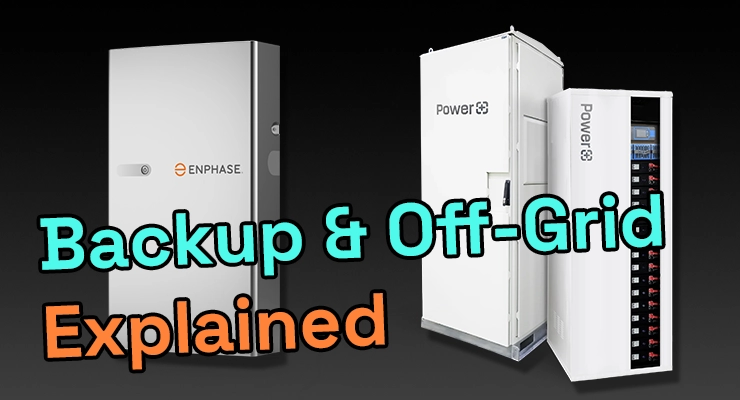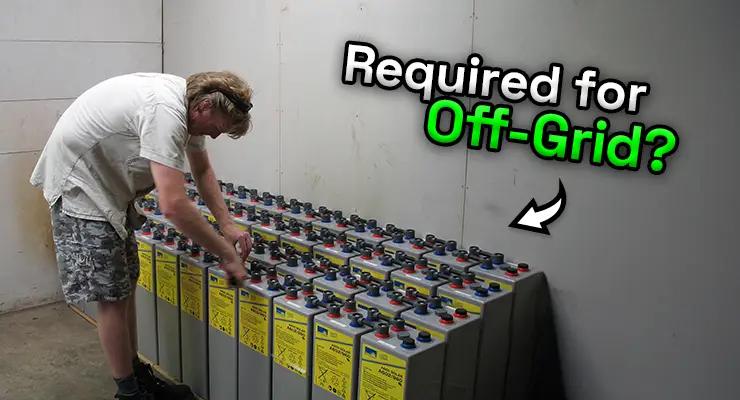Fast read
Solar battery backup, often called a hybrid system, keeps you connected to the main electricity grid while using a battery to store excess solar power for use during blackouts or at night. Full off-grid capability means you are completely disconnected from the grid, relying entirely on your own solar panels, a much larger battery bank, and often a backup generator for all your power needs. The key differences are grid-connection, system size, upfront cost, and the level of energy independence and management required.
What’s the difference between solar battery backup and full off-grid capability?
Deciding to invest in solar and battery storage is a significant step toward energy independence. However, the terms “battery backup” and “off-grid” are often used interchangeably, leading to confusion. While both involve storing solar energy, they represent two fundamentally different approaches to how you power your home and interact with the electricity grid.
Understanding this distinction is crucial. One provides a safety net for power outages while lowering bills, and the other is a complete lifestyle commitment to self-sufficiency. This article will clarify the differences to help you decide which path aligns with your energy goals, budget, and property location.
What is solar battery backup (a hybrid system)?
A solar system with battery backup, technically known as a hybrid system, is the most common setup for Australian homes in urban and suburban areas. In this configuration, your property remains connected to the national electricity grid.
Here’s how it works:
- Solar Generation: Your rooftop solar panels generate DC electricity from sunlight during the day.
- Powering Your Home: This energy flows to a hybrid inverter, which converts it to AC electricity to power your appliances.
- Charging the Battery: Any excess solar energy not immediately used is directed to charge your home battery.
- Evening & Low-Light Use: When the sun goes down or on cloudy days, your home draws power from the stored energy in the battery.
- Grid as a Safety Net: If your battery is depleted and your panels aren’t generating, you automatically and seamlessly draw power from the grid.
The core benefit of a hybrid system is flexibility and resilience. You maximise the use of your own solar energy, reducing reliance on the grid and cutting your power bills. Crucially, during a power outage, the hybrid inverter can isolate your home from the grid and use the battery to power essential circuits, a function known as “islanding.” This ensures your lights, fridge, and other critical devices stay on when the neighbourhood goes dark.
What is full off-grid capability?
Full off-grid capability, also called a Stand-Alone Power System (SAPS), means your property has no physical connection to the electricity grid. You are 100% responsible for generating, storing, and managing every watt of electricity your household consumes. This is most common for remote or rural properties where connecting to the grid is either impossible or prohibitively expensive.
An off-grid system is far more complex and robust than a hybrid system. Its essential components include:
- A Larger Solar Panel Array: You need to generate enough power to meet your daily needs and fully charge your batteries, even during the shorter, cloudier days of winter.
- A Substantial Battery Bank: The battery system must be large enough to store multiple days’ worth of energy to carry you through extended periods of bad weather.
- A Capable Off-Grid Inverter/Charger: These are more powerful and robust than hybrid inverters, designed for continuous, heavy-duty operation and managing energy flow between panels, batteries, and a generator.
- A Backup Generator: Almost all off-grid systems include a backup generator (usually diesel or petrol) as a final safety net to charge the batteries if several days of poor weather deplete your storage.
Living off-grid is a significant commitment that often requires lifestyle adjustments to be more mindful of energy consumption.
Key differences at a glance
- Grid Connection: Hybrid systems remain connected to the main grid. Stand-alone systems have no connection to the grid.
- Primary Goal: Hybrid systems focus on bill reduction and backup power during outages. Stand-alone systems aim for complete energy independence.
- System Size: Hybrid systems are sized to offset usage, with the grid as a backup. Stand-alone systems must be oversized to meet 100% of needs, plus a buffer for bad weather.
- Upfront Cost: Hybrid systems are moderate to high, but significantly less than off-grid. Stand-alone systems are very high due to the larger solar array, massive battery bank, and generator.
- Components: Hybrid systems use solar panels, a hybrid inverter, and a battery. Stand-alone systems use solar panels, an off-grid inverter/charger, a large battery bank, and a backup generator.
- Reliability: Hybrid systems are extremely reliable, using the grid as an infinite backup. Stand-alone system reliability is high but depends entirely on system design, maintenance, and user energy management.
- Lifestyle: Hybrid systems require minimal changes to energy use. Stand-alone systems require active energy management and potential lifestyle adjustments.
Which system is right for you?
Choosing between battery backup and a full off-grid system depends entirely on your circumstances and goals.
You should consider a hybrid system with battery backup if:
- You live in an area with a reliable grid connection.
- Your main goals are to lower your electricity bills and have power during blackouts.
- You have a moderate budget.
- You want the peace of mind that comes with having the grid as a fail-safe.
A great example of technology for this purpose is a hybrid inverter from a reputable manufacturer like Sungrow, paired with a modular battery. The Sungrow SH-RS series, for instance, is designed for grid-connected homes, offering efficient energy management and reliable backup power when needed.
You should consider a full off-grid system if:
- Your property is in a remote location where grid connection costs are excessive (typically over $25,000).
- You are committed to complete energy independence and severing ties with utility companies.
- You have a substantial upfront budget for the larger system and a backup generator.
- You are prepared to actively monitor and manage your energy usage.
A final word on safety and compliance
Regardless of the system you choose, installation must be performed by a licenced electrician and accredited installer. All systems, whether grid-connected or stand-alone, must comply with relevant Australian Standards, including AS/NZS 5033 for solar arrays and the crucial AS/NZS 5139 for battery storage safety. These standards ensure your system is installed safely, protecting your family and property.
Ultimately, the choice between backup and off-grid is a choice between resilience and complete self-reliance. By understanding the fundamental differences in cost, complexity, and lifestyle, you can make a confident and informed decision for your energy future.





